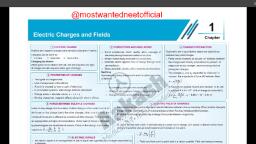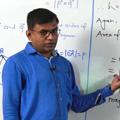Page 1 :
Chapter 4, , Motion in a Plane, , e Introduction, e Scalars and Vectors, , © Multiplication of Vectors by, Real Numbers, , e Addition and Subtraction of, , Vectors - Graphical Methods, © Resolution of Vectors, , © Vector Addition - Analytical, Method, , e Motion in a Plane, , e Motion in a Plane with, Constant Acceleration, , e Relative Velocity in Two, Dimensions, , © Projectile Motion, , Uniform Circular Motion, Some Important Definitions, e@ Formulae Chart, , © Quick Recap, , Chapter Contents, , Introduction, , We come across many examples of objects moving in a plane or in, space, in our daily lives. To develop a better understanding of these, situations. and to interconnect the various related quantities, we, undertake the discussion of motion in a plane. We will start with, vectors. Their knowledge is very important in our study. We will learn, to define displacement, velocity and acceleration in a plane using, vectors. We will discuss projectile motion, and uniform circular motion, as special cases of motion in a plane., , But before that we need to have the knowledge of vectors., , SCALARS AND VECTORS, Scalars, , These are physical quantities which need only a magnitude and an appropriate, unit for their complete specifications. For example mass, body temperature,, energy needed to perform some task etc. All these are scalar quantities as, they do not have any direction associated with them. Such quantities can be, added or subtracted using the rules of simple algebra. However we have to take, care of a few things while doing so. These are, , (i) | Only similar quantities can be added or subtracted i.e., the quantities, having same units., , , , For example, if the mass of an empty box is 5 kg, and it is filled, with 10 kg of grains, then the total mass of the box now becomes, 5 kg + 10 kg = 15 kg., , It does not make any sense when we talk of adding mass of the box, to the total volume of the box., , (ii) The quantities having different units can only be divided or multiplied with, each other., , Aakash Educational Services Pvt. Ltd. Regd. Office : Aakash Tower, 8, Pusa Road, New Deihi-110005, Ph. 011-47623456
Page 2 :
156, , Motion in a Plane Board & Competitive Exams., , , , Vectors, , How, , Sometimes, mere knowledge of magnitude and the unit of the quantity is not sufficient to describe it, completely. For example, if we want to know the effect produced by applying a 4 N force on a moving, toy car, we can get different results. It is so, because if we apply the force in the direction in which, the car is moving, it will speed up. But if we apply the same force opposite to the direction of the, motion of the car, it will slow down. So we say that force is a quantity that has both magnitude and, direction., , Moreover if we want to know the effect produced due to two different forces acting simultaneously on the toy, car, we can not get the right result by merely adding their magnitudes algebraically (as in case of scalars)., Two forces, having different directions, applied simultaneously on the car, might produce an effect in a third, direction. The resultant of the two forces in this case can be obtained by the triangle law or parallelogram, laws of addition, which we will learn in this chapter., , The physical quantities like force, which have both magnitude and direction and obey triangle law or, parallelogram law of addition, are known as vector quantities. Some other vector quantities are displacement,, velocity, acceleration, momentum etc., , to Represent a Vector ?, In books a vector is either represented by a bold face type of its symbol, or by an arrow placed on its symbol., For example, displacement S can be either represented by S or by S., , Graphically, a vector is represented by a line segment, with an arrow at one of its ends. The length of the, line segment is proportional to the magnitude of the vector and the arrow head tells the direction of the vector., , ere, , For example, for a vector S , as shown in the figure, length of the line segment gives an idea about the, magnitude of S , while the arrow head shows its direction. Here, we can also write S = PQ ., , The magnitude of a vector § is often called its absolute value and is denoted as | S| or simply S., , Position and Displacement Vectors, , Position vector : It is used to describe the position of an object in space. For this we have to choose a, reference frame. Suppose the object is moving in a plane. We can represent that plane by x-y plane with its, origin at O., , Position vector of the object is the vector joining the origin to the point where the object lies directed from, origin to the point., , Let an object be located at point P in space, then the position vector of point P is the line OP having an, arrow at point P. It is usually denoted by 7 ., , y, , So OP =r, , Aakash Educational Services Pvt. Ltd. Regd. Office : Aakash Tower, 8, Pusa Road, New Delhi-110005, Ph. 011-47623456
Page 3 :
Board & Competitive Exams. Motion ina Plane 157, , Displacement vector : When an object is displaced from its position at point P to a new position at point P”, (say), then the vector PP” having its tail at P and head at FP’ is called the displacement vector of the object, corresponding to its motion from P to P’. Displacement vector of object for any two points does not depend, on the path followed by the object i.e., even if the object goes from point P to P’ through path -1 or through, , path - 2 instead of path - 3 (see figure). Its displacement remains the same and is shown by the vector PP’ ., , Path-1, , ¥, , , , x, , The magnitude of the displacement vector i.e., | PP’ | is either less than or equal to the length of the actual, path followed by the object between the two points., , Equality of vectors : Two vectors having same direction and equal magnitude are said to be equal, vectors. This is the necessary and sufficient condition for any two vectors to be equal., , pee, , Vectors P andQ@ shown in the figure are equal vectors as they have same direction and magnitude. If we, shift any of these vectors parallel to itself, and make it overlap with the other, the two vectors will completely, coincide with each other., , If two vectors P and @ are equal, we can write P =, , Note: if a vector is moved parallel to itself, it represents a vector equal to itself i.e., the same vector., Such vector which can be freely moved parallel to themselves are called free vectors. They do not have, , fixed locations., e However in some cases location or the line of application of a vector is important. Such vectors are, called localised vectors., , Inthis chapter we deal with free vectors unless stated otherwise., , MULTIPLICATION OF VECTORS BY REAL NUMBERS, , When a vector A is multiplied by a real number n, the quantity obtained is a vector nA whose magnitude is n, times that of the original vector., |nA|=n| A|. Its direction might be the same or opposite to that of the original vector depending upon whether n, is positive or negative., (i) Ifnis apositive number, nA and A have the same direction., Ais, 6, ———, , (ii) If nis anegative number, nA and A have opposite directions., , ie., ———_, , Aakash Educational Services Pvt. Ltd. Regd. Office : Aakash Tower, 8, Pusa Road, New Deihi-110005, Ph. 011-47623456
Page 4 :
158 Motion in a Plane Board & Competitive Exams., , (iii) If n is zero, the magnitude of NA is also zero. Such a vector, whose magnitude is zero is called a zero, vector or a null vector and is denoted by 6., OA=6, Since the magnitude of a null vector is zero, its direction cannot be specified., , (iv) If nis a scalar quantity rather than just being a pure number, then the dimension of nA is the product of, dimensions of n and A. For example, if n gives the mass of a body and A be its acceleration, then the, vector nA will have dimensions of force., , ADDITION AND SUBTRACTION OF VECTORS-GRAPHICAL METHOD, Head to tail method : Simple laws of algebra cannot be applied to add vectors., ze, , ———_>, , A, i), Suppose A and B be two vectors as shown in the figure (i). To obtain A + B , we shift B parallel to itself so that, , , , its tail coincides with the head of A. The line segment joining the tail of A to the head of B represents, A + B and its direction is as shown in the figure (ii)., a”, , AACE, Lh, A, (ii), If instead of B , we shift A parallel to itself such that the tail of A coincides with the head of B, the vector, obtained by joining the tail of B to the head of A gives B+ A., A, , B +a, , -—=—>, (iii), , Ifwe compare A +B and B + A from figures (ii) and (iii), we find the two vectors are equalie.A+B=B+A., It shows that vector addition of two vectors is commutative. In a similar manner it can also be proved that, vector addition is associative, ie., A+(B+C)=(A+B)+C, The above method of adding vectors is known as head to tall method or triangle law of addition because, the two vectors and their resultant form three sides of a triangle., , Note : When you write R = A + B, then it is true that R is greater than A and B but when you are writing, R=A + B the meaning becomes entirely different. Here R, A & B will form a triangle and, their magnitudes are the three sides of the triangle. As the magnitude of R now can be any side, of the triangle the magnitude of R need not always be greater than A (magnitude of A) or, , B(magnitude of B), , Aakash Educational Services Pvt. Ltd. Regd. Office : Aakash Tower, 8, Pusa Road, New Delhi-110005, Ph. 011-47623456
Page 5 :
Board & Competitive Exams. Motion ina Plane 159, , Parallelogram Method : This method is equivalent to the triangle method of vector addition., , In this method any one of the vectors is shifted parallel to itself such that its tail coincides with the tail of the, other vector as shown below. Let the point of coincidence be named O. If we draw the parallelogram whose, , sides are represented by AandB. Then A+B is given by the diagonal of this parallelogram which passes, through O., , , , Thus, the tail of vector R coincides with the tail of A and B in this case. If we find the sum of these vectors, , using triangle method as shown below, we obtain the same resultant ie., R=A+B. That is why the two, methods are equivalent to each other., , , , Subtraction of Vectors, , Subtraction of Vectors : The subtraction of a vector B from another vector A is actually the vector sum of the, vectors A and-B., , Thus A -B = A+(-B), , , , -Bis a vector equal in magnitude and opposite in direction to vector 8. Compare the vectors, A-—Band A+8 shown in the figure ahead., , Ifa vector is subtracted from itself ie., Ais added to — A,, the resultant is a zero vector., ie., A+(-A)=6, , Physically it implies that if a body goes from one point to another, point and again comes back to the initial point in a given interval, then, its net displacement is zero during that interval., , Properties of null vector :, , , , @ A+O=A, (i) nb=6, (ii) OA=6, ) [d|=0, As a null vector has zero magnitude, its direction can not be specified., , Aakash Educational Services Pvt. Ltd. Regd. Office : Aakash Tower, 8, Pusa Road, New Delhi-110005, Ph. 011-47623456


























































